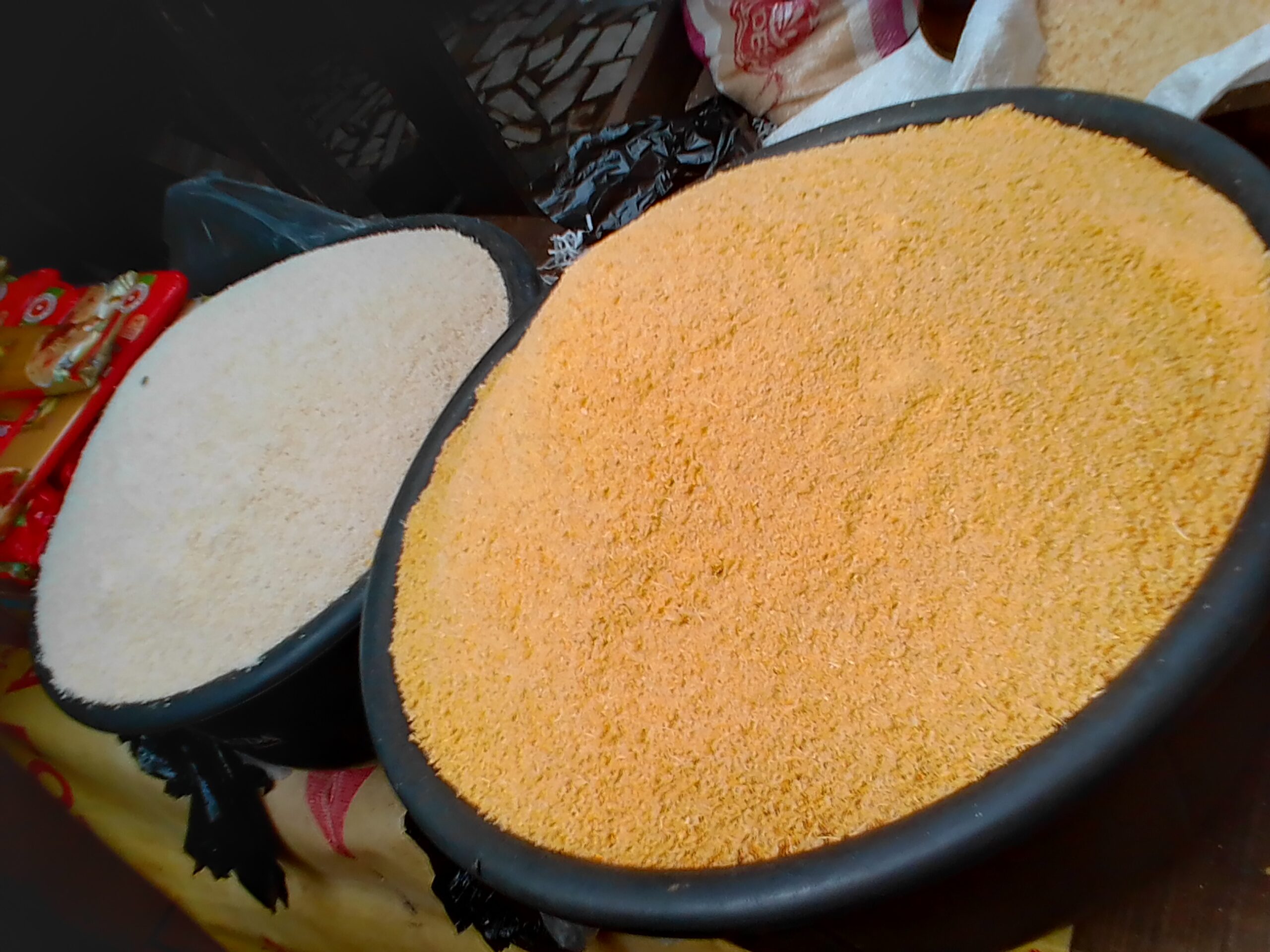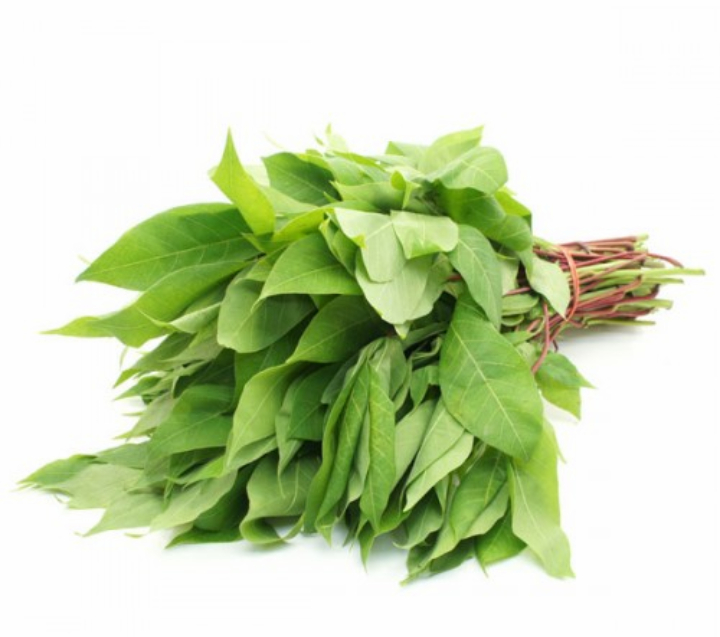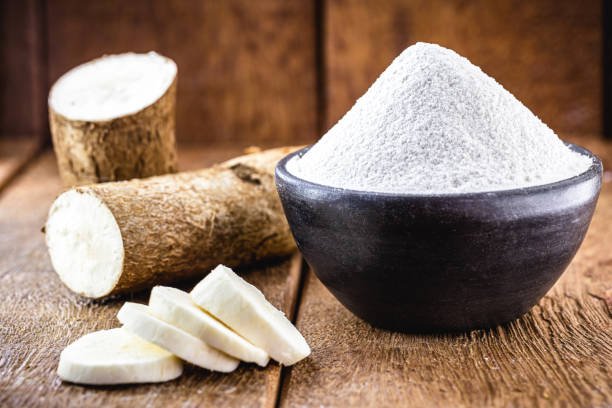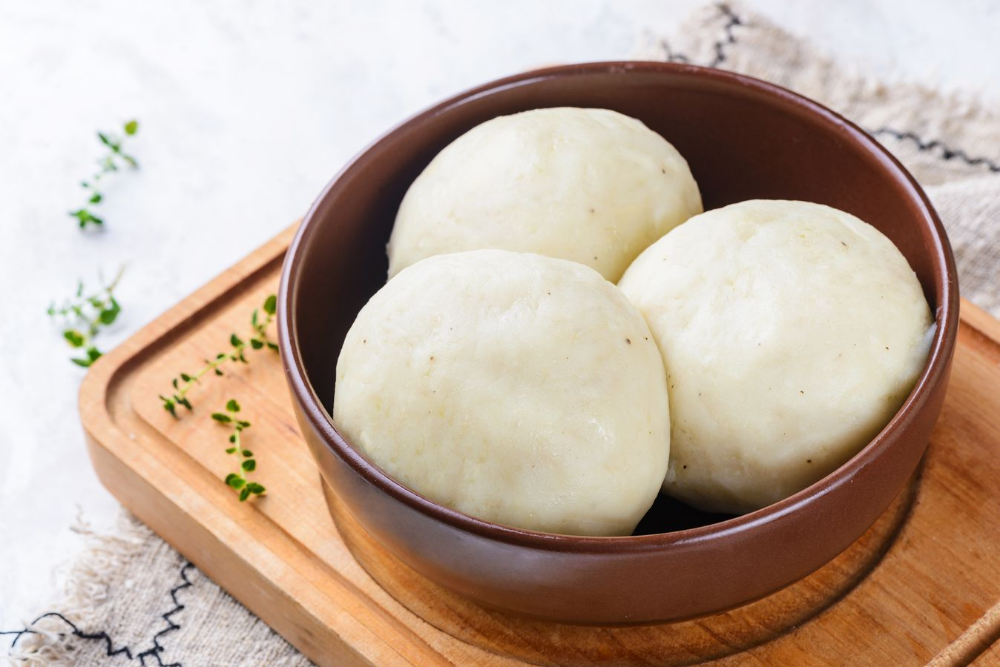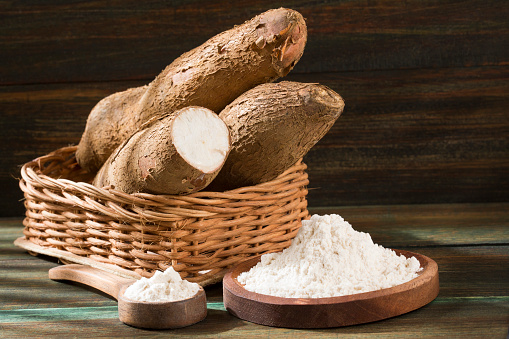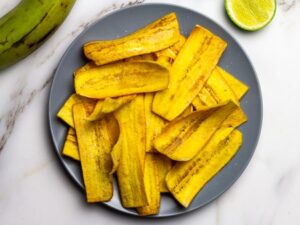Cassava (Manihot esculenta) is an agricultural root vegetable widely consumed in many countries around the globe. It provides many important nutrients, including resistant starch, which may have health benefits. You probably want to know some by products of cassava
Nevertheless, as with all foods, you should be mindful to consume it and its products in moderation. This is especially true considering that it’s fairly high in calories and contains some chemicals which may not be too good for the body system.
By products of cassava
1. Garri

In West Africa, garri refers to the creamy granular flour obtained by processing the starchy tuberous roots of freshly harvested cassava.
The cassava tubers are peeled, washed, grinded then the water in it is pressed out with a traditional machine. When dry, it is sieved so the real garri is gotten, which is then fried to get the final result.
They are of two types, the white garri and the yellow garri, yellow is gotten by simply adding palm oil while grinding. Garri can be eaten with water, groundnut and sugar, some persons add milk to theirs just to spice things up. I like mine with just very cold water and plenty groundnuts. No sugar please.
For a full meal, garri is usually cooked by adding it to hot water, then turning it into dough. This is eaten with different types of thick, leafy vegetable soups, melon seed soups, groundnut soups and the likes.
Read also: Cassava farming
2. Kisamvu
This is one is from Tanzania. And it is made from fresh cassava leaves, incase you don’t know, fresh cassava leaves have got lots of nutritional benefits.
Kisamvu vegetable is made by first chopping the leaves or grinding it before cooking it. This helps to remove the cyanogen it contains.
This vegetable is prepared by crushing the leaves with a mortal and pestle to produce a very fine pulp. Boil water, add salt to the crushed leaves, stir continuously until the leaves are cooked. Put aside.
Then fry your onions, add some peanut butter or coconut milk. When the mixture starts to boil, add your cooked cassava leaves, stir for a few more minutes and kisamvu is ready. Serve with rice or other main cereal based dish and enjoy your meal.
3. Kwem
Kwem is a local cuisine having the taste of raw grass. It is highly appreciated by the people of the South due to the fact that it contains so much nutrients that is very vital and essential to the human body as it adds Iron and purifies the blood against acids and any harmful material in the body.
This local cuisine is being cooked in the Southern part of Cameroon. They savage it as they eat it from Monday to Sunday, be it in the morning, in the afternoon or in the evening. They consider it useful to the human body than any other food they have in their possession.
Kwem is made by first rinsing your cassava leaves, chopping your leaves. After cutting your leaves, wash them three to four times making sure to remove any possible dirt from it, place in a clean bowl and cover. Then wash your chicken and cut into smaller sizes.
The next thing to do is to boil the chicken, then add onions inside while boiling, allow it to boil for a period of thirty minutes. After thirty minutes, remove the chicken from fire and separate it from the stuck water, the next thing to do is to to fry the chicken, fry them all, either too dry or just lightly dry.
From here, proceed with the next thing, which is washing your onions, garlics and ginger, remove their peelings and chop into smaller sizes, then grind the onions, garlics and ginger together.
Move next to the groundnut. Boil hot water for a period of fifteen minutes, pour the boiled hot water into the groundnut, allow the groundnut for a period of five to ten minutes for it to start peeling off. When it begins to peel offs, remove the remaining peelings with your hand, if it turns out to be hard to remove on its own.
After this, grind the groundnut using the molinex. But before grinding the groundnut, remove the peelings of the groundnut as it gives more taste to the food. This is a part of the secret when cooking kwem.
From here, place your pot on fire and pour in oil. Pour in the grinded onions, ginger and garlics into the pot and add salt and maggi also. Stir your pot and allow it for a period of five minutes. Throw in the cassava leaves and also the fried chicken.
Stir the pot and after a period of five minutes, pour in water. The next thing is to pour in the stuck water, like a cup of it, make sure not to close the pot with a lid as the groundnut will pour out. Allow the food on fire for a period of twenty minutes, after twenty minutes, your food is ready.
4. Cassava flour
Cassava flour is a good substitute for wheat flour in a variety of recipes. To make cassava flour, a person must grate cassava, dry it out, and grind it to a fine powder.
Cassava flour features in a number of recipes. As cassava flour is gluten-free, people who avoid gluten can use it as a replacement for wheat flour in a variety of recipes.
5. Tapioca snack
This snack is typical of Igbos in the Eastern part of Nigeria and the combo is really appetizing if you want something to snack on especially in hot weathers.
Peel cassava (remove the back) and cut into big slices, wash and add into a cooking pot, add water to the level of the cassava in the pot and cook for 25-30minutes, once cooked remove from the water and allow to cool.
Read also: Plantain by products
Using your grater(the part for chips) or a clean knife, slice thinly in long strips until all the cassava are cut (if it’s sticky to the blades, dab blades with palm oil to stop it from being sticky), add all the sliced cassava into a big bowl and add water way above the cassava this time. Allow sit overnight.
By morning; wash the cassava thoroughly with clean water(you’ll notice it’s slimy) until it’s not slimy anymore and the water is now crystal clear. Break up and remove the shells of the coconut, then wash thoroughly.
Read also: Agricultural processing
Serve coconut with the tapioca snack in cold water and enjoy. Note: tapioca snack can be refrigerated, however always keep in in clean water and change water often until you’ve consumed it all.
6. Fufu
Fufu is a dough-like food made from fresh or fermented cassava, found in West African as well as Caribbean cuisines. It is a starchy food that is usually eaten with any kind of soup or vegetables.
Peel the cassava. Cut each tuber into 5 or 6 pieces. Use a knife to peel off the whole skin. Wash the cassava thoroughly and place in a large container. Pour in water to completely cover the cassava. Cover the container and keep it to ferment in a warm corner for 3 – 5 days.
To check if the cassava is well fermented, press with your fingers, if it is soft then it is okay. Note that all might not be very soft but if most are soft then you are good to go. Strain the fermented cassava to remove excess water. Then place in a blender or food processor and process into a puree.
Now remove any fiber you see in the puree. Pour the puree into a clean kitchen towel then squeeze to remove excess water. When the excess water is out, your fufu is ready to be cooked. Fufu is one of the cassava by products I really don’t live eating.
Place the raw fufu in a pot then run through it with your hands to dissolve any excess lumps. Add a quarter cup of water and mix to form a paste. Place on medium high heat then cover and let it rest for two minutes. Begin stirring with a wooden spoon, mixing hard enough to dissolve the lumps that form as it cooks.
Add water as needed while stirring to ensure that the fufu is not too strong. Keep mixing on heat until the fufu moves from being bright white to an off-white color. It is ready when it is an off-white color. Turn off the heat then mold the fufu into lumps. Your fufu is ready and you can enjoy it with any soup of your choice.
7. Cassava pasta
Cassava pasta is everything you ever wanted–flavorful, tender and delicious. To make your own pasta, you’ll need cassava flour, ground flax seeds and water. That simple.
see how you can make your homemade cassava pasta here.
8. Cassava bread
Just the way wheat flour is used in making our normal bread, cassava flour is also used in making cassava bread. unfortunately I really don’t know how this taste like, cause i haven’t seen none of it in my country.
You can check how this bread is made here.
9. Cassava starch
Cassava contains a lot of starch and is called the “king of starch”. Compared with being eaten directly, more cassava is used to extract cassava starch. Because cassava starch has a wide range of uses and has a large market demand.
Read also: Cashew by products
Moreover, with the development of science and technology, the starch produced by modern cassava starch processing equipment is of high quality and fast production efficiency. In some African countries, the cassava starch extraction business is favored.
10. Livestock feed
Animals and livestock are important to the world ecosystem and feeding. They produce milk, meat, wool and other essentials we humans can’t do without. Yes it’s one of the cassava by products.
Animal breeders in Europe and America make use of cassava products like flakes, pellets, chips, cubes and flours to feed their farm animal in order to get top yield. This is because these cassava products are cheap and deliver good results at the end of the farming period.
This is why cassava product from Nigeria have become of high demands for farmers in countries like Germany, France, US, UK and the Netherlands.
That’s pretty much it for the by products of cassava.
There’s love in sharing!
